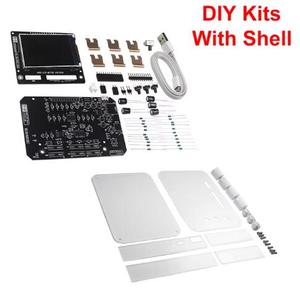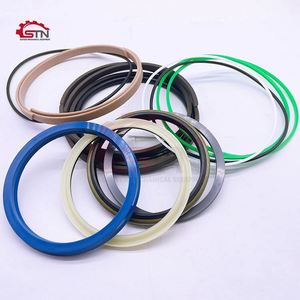(195 products available)

































































































































































A LCR kit is a set of tools and equipment used for measuring the inductance, capacitance, and resistance of electronic components. LCR stands for Inductance, Capacitance, and Resistance. These are the three fundamental electrical properties that define the behavior of passive components in an electronic circuit. Here's a breakdown of its fundamental types:
Inductance L
LCR measures the inductance of a coil or inductor. Inductance is the property of a conductor by which a change in the electric current through it produces an electromotive force (EMF) either in the conductor itself or in a nearby conductor. The unit of inductance is the Henry (H).
Capacitance C
The LCR measures the capacitance of a capacitor. Capacitance is the ability of a component or circuit to store electrical energy in an electric field. The unit of capacitance is the Farad (F).
Resistance R
The LCR measures the resistance of a resistor. Resistance is the opposition to the flow of electric current. The unit of resistance is Ohm (Ω).
Depending on the kind of measurements one wants to take, there are different types of LCR meters. Here are some of them:
Digital LCR Meter
This is a sophisticated device that displays the measurement result in digital form. It provides a more accurate measurement than its predecessor, the analog LCR meter, and can measure L, C, and R simultaneously. It often has a wide frequency range.
Handheld LCR Meter
Handheld LCR meters are portable and convenient for field use. They are smaller and lighter but still provide reasonably accurate measurements. They are ideal for on-site testing of components and circuits.
Precision LCR Meter
These meters offer high accuracy and are used in laboratory environments. They can measure very low or very high values of L, C, and R with great precision. They often have advanced features for detailed analysis.
High-Frequency LCR Meter
These meters are designed to measure components at high frequencies, which is essential for RF (Radio Frequency) applications. They can accurately measure the behavior of components at their operating frequencies.
Impedance Analyzer
While not an LCR meter in the traditional sense, impedance analyzers can measure the impedance of a component over a range of frequencies, providing a detailed view of its behavior in AC circuits.
LCR meter kits are accessible in different designs. The design of an LCR meter kit is essential for its performance and usability. Here are some key design elements to consider:
Measurement Circuitry
The measurement circuitry is the heart of the LCR meter. It accurately determines the capacitance, inductance, and resistance of components. High-frequency signals are often used for capacitance and inductance measurements. A precision oscillator generates a known frequency and voltage. The resulting current is measured with a high-resolution ADC. For resistance measurements, a constant current source is used, and the voltage drop across the component is measured. The design must ensure minimal signal loss and noise interference. This is often achieved with shielded cables and careful PCB layout.
User Interface
The user interface of an LCR meter kit impacts how easily users can interact with the device. A simple and intuitive interface is crucial for efficient operation. It typically consists of a digital display, often an LCD or OLED screen. This shows measurement results clearly and concisely. It may also include additional information such as frequency, voltage, and measurement mode. Control knobs and buttons are used to set parameters and navigate menus. Some advanced models offer USB or Bluetooth connectivity for data transfer and remote control. A well-designed user interface enhances the user experience and improves measurement accuracy by allowing quick adjustments and settings.
Power Supply
The power supply design of an LCR meter kit is critical for its reliability and performance. It must provide stable and clean power to the measurement circuitry. This often involves linear regulators to minimize noise. Battery-operated models offer portability and convenience, but they require efficient power management to extend battery life. AC-powered LCR meters may use switch-mode power supplies to accommodate varying input voltages. The design must ensure that power fluctuations do not affect measurement accuracy. This can be achieved with decoupling capacitors and voltage reference circuits.
Enclosure and Ergonomics
The enclosure design of an LCR meter kit affects its durability and ease of use. It should protect internal components from environmental factors like dust and moisture. Materials such as plastic or metal are commonly used. The design impacts the device's weight and portability. Ergonomics play a significant role in user interaction. A well-designed LCR meter should fit comfortably in hand and have controls within easy reach. Portable LCR meters should be lightweight and compact for easy transport. The enclosure design can also influence heat dissipation and airflow, which are important for maintaining optimal operating temperatures.
Calibration and Accuracy
Calibration is a critical aspect of maintaining accuracy in an LCR meter kit. It involves adjusting the device to ensure that its measurements align with known standards. This process typically requires precision reference components with known values of capacitance, inductance, and resistance. The LCR meter measures these values and adjusts its internal settings to minimize discrepancies. Regular calibration is essential to account for factors such as temperature variations, aging components, and manufacturing tolerances. A well-calibrated LCR meter provides reliable and accurate measurements, which are crucial for testing and analyzing electronic components in various applications.
A leak detection LCR meter can be used for various applications. Here are some wearing and matching suggestions for the kit:
Wearing suggestions
Wear a leak detection LCR meter in casual attire when conducting simple electronic testing. Put on a well-fitting t-shirt and a pair of comfortable jeans, for example. This allows free movement and enables one to focus on the task at hand without distractions. When testing in a formal setting, like an office or laboratory, wear business casual attire. A button-up shirt and khaki pants will suffice. This shows professionalism and respect for the environment. Also, wear closed-toe shoes. Do not wear sandals or flip-flops.
Matching suggestions
Pair the LCR meter with the right multimeter for the job. For beginners, match it with a basic multimeter that measures capacitance and resistance. This helps one learn the basics without getting overwhelmed. As one advances, pair the LCR meter with a high-end multimeter that measures inductance accurately. This ensures precise readings for complex circuits. Also, consider the brand. Some brands have LCR meters that work better with their multimeters. Check compatibility before purchasing. This saves time and ensures accurate measurements.
Q1: What is the purpose of an LCR kit?
A1: The LCR kit is used to measure the inductance, capacitance, and resistance of electronic components. It provides accurate and reliable measurements for troubleshooting and testing purposes in electronic circuits.
Q2: How does an LCR meter work?
A2: An LCR meter applies a small AC voltage to the component under test and measures the resulting current. It calculates the impedance and phase shift to determine the inductance, capacitance, or resistance values.
Q3: What are the key specifications to consider when purchasing an LCR meter kit?
A3: Important specifications include measurement range, frequency range, accuracy, display type, and connectivity options. These factors determine the meter's capabilities and suitability for specific applications.
Q4: Can an LCR meter measure components in-circuit?
A4: Some LCR meters can measure components in-circuit, but accuracy may be affected by parallel or series connections with other components. It's often better to test components out-of-circuit for precise measurements.
Q5: What are the different types of LCR meters available?
A5: There are handheld LCR meters, benchtop LCR meters, and portable LCR meter kits. Handheld meters are suitable for fieldwork, while benchtop meters offer higher accuracy and advanced features. Portable kits provide versatility and convenience for various testing applications.